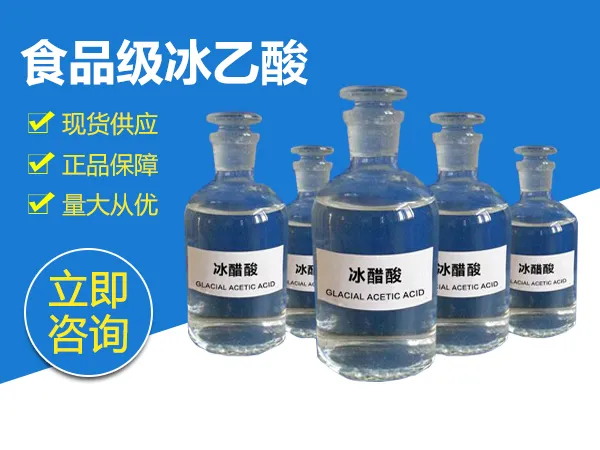
Dec . 11, 2024 09:24 Back to list
Understanding the Chemical Structure and Properties of Glacial Acetic Acid
The Chemistry and Applications of Glacial Acetic Acid
Glacial acetic acid, with the chemical formula \( CH_3COOH \), is a colorless, liquid organic compound that is widely used in various industries due to its unique properties and versatile applications. This article will explore the characteristics, production, uses, and safety considerations associated with glacial acetic acid.
Understanding Glacial Acetic Acid
Glacial acetic acid is a concentrated form of acetic acid, typically containing at least 99% acetic acid by weight. Its name derives from the fact that it can solidify into ice-like crystals at temperatures below 16.6 degrees Celsius (62 degrees Fahrenheit). This makes it distinct from the more common vinegar, which contains about 4-8% acetic acid and is used as a condiment and preservative.
The chemical structure of glacial acetic acid consists of a methyl group (-CH3) connected to a carboxyl group (-COOH). This structure gives acetic acid its characteristic acidic properties, allowing it to participate in a variety of chemical reactions.
Production of Glacial Acetic Acid
There are several methods of producing glacial acetic acid, but the most common ones include carbonylation of methanol and the oxidation of hydrocarbons.
1. Carbonylation of Methanol This method, also known as the Monsanto process, involves the reaction of methanol with carbon monoxide in the presence of a catalyst, usually rhodium. The result is the formation of acetic acid, which can be subsequently purified to obtain glacial acetic acid.
2. Oxidation of Hydrocarbons Another method involves the oxidative cleavage of alkenes or catalytic oxidation of naphtha and butane. This approach is less common than carbonylation but can yield high amounts of acetic acid.
Uses of Glacial Acetic Acid
Glacial acetic acid has a wide range of applications across various industries
glacial acetic acid formula

- Chemical Synthesis It is widely used as a solvent and reactant in the synthesis of various chemical compounds, including acetic anhydride, acetate esters, and acetic acid-based polymers. These derivatives are important in the production of textiles, plastics, and coatings.
- Food Industry While glacial acetic acid itself is not directly used in food, it serves as a precursor to many food additives and flavoring agents, most notably for vinegar production.
- Pharmaceuticals In the pharmaceutical industry, glacial acetic acid is a key component in the manufacture of certain medications and is used as a solvent in drug formulation.
- Textile Industry It is employed in the textile industry for dyeing and as a cleaning agent. Its ability to maintain pH balance is particularly useful during the dyeing process.
- Household Products Glacial acetic acid is also found in many household cleaning agents and descaling products due to its effectiveness in breaking down mineral deposits and grime.
Safety Considerations
Despite its widespread use, glacial acetic acid can pose significant hazards. It is classified as a corrosive substance, which means it can cause severe burns upon contact with skin or eyes. Inhalation of its vapors can lead to respiratory irritation and damage to mucous membranes. Therefore, when handling glacial acetic acid, it is crucial to wear appropriate personal protective equipment, including gloves, goggles, and respirators, if necessary.
Additionally, it should be stored in well-ventilated areas, away from heat and incompatible substances such as strong bases and oxidizing agents. Proper training and adherence to safety protocols are essential to minimize risks associated with its handling and use.
Conclusion
Glacial acetic acid is a vital chemical with a myriad of applications across industries ranging from chemical manufacturing to textiles and pharmaceuticals. Understanding its properties, production methods, and safe handling procedures is essential for those who work with this compound. As industries continue to innovate and develop new uses for acetic acid, its importance in both industrial and household applications is likely to grow, underscoring the need for ongoing research and safety awareness in its use.
-
SmartAgri Solutions - Precision Farming&Soil Monitoring
NewsJul.13,2025
-
Industrial Solutions-Example Inc.|Smart Manufacturing&Energy Efficiency
NewsJul.13,2025
-
Food Grade Glacial Acetic Acid-Pure Quality|High-Purity Acetic Acid,Food-Grade Chemical
NewsJul.13,2025
-
Industrial Efficiency Solutions-NextGen Technologies|Advanced Automation&Data-Driven Analytics
NewsJul.12,2025
-
Smart Manufacturing Solutions-Example.com|Enhance Efficiency&Reduce Costs
NewsJul.12,2025
-
Food grade glacial acetic acid
NewsMar.07,2025
